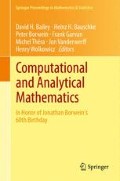Abstract
For an integer b ≥ 2 a real number α is b -normal if, for all m > 0, every m-long string of digits in the base-b expansion of α appears, in the limit, with frequency b − m. Although almost all reals in [0, 1] are b-normal for every b, it has been rather difficult to exhibit explicit examples. No results whatsoever are known, one way or the other, for the class of “natural” mathematical constants, such as \(\pi,\,e,\,\sqrt{2}\) and log2. In this paper, we summarize some previous normality results for a certain class of explicit reals and then show that a specific member of this class, while provably 2-normal, is provably not 6-normal. We then show that a practical and reasonably effective pseudorandom number generator can be defined based on the binary digits of this constant and conclude by sketching out some directions for further research.
Access this chapter
Tax calculation will be finalised at checkout
Purchases are for personal use only
References
Bailey, D.H., Crandall, R.E.: Random generators and normal numbers. Exp. Math. 11(4), 527–546 (2002)
Bailey, D.H., Misiurewicz, M.: A strong hot spot theorem. Proc. Am. Math. Soc. 134(9), 2495–2501 (2006)
Bailey, D.H., Borwein, P.B., Plouffe, S.: On the rapid computation of various polylogarithmic constants. Math. Comput. 66(218), 903–913 (1997)
Bailey, D.H., Borwein, J.M., Crandall, R.E., Pomerance, C.: On the binary expansions of algebraic numbers. J. Number Theor. Bordeaux 16, 487–518 (2004)
Borwein, J., Bailey, D.H.: Mathematics by Experiment: Plausible Reasoning in the 21st Century. AK Peters, Natick (2008)
Cassels, J.W.S.: On a problem of Steinhaus about normal numbers. Colloq. Math. 7, 95–101 (1959)
Champernowne, D.G.: The construction of decimals normal in the scale of ten. J. London Math. Soc. 8, 254–260 (1933)
Copeland, A.H., Erdös, P.: Note on normal numbers. Bull. Am. Math. Soc. 52, 857–860 (1946)
Hida, Y., Li, X.S., Bailey, D.H.: Algorithms for quad-double precision floating point arithmetic. 15th IEEE Symposium on Computer Arithmetic. IEEE Computer Society, pp. 155–162. California University, Berkeley (2001)
Knuth, D.E.: The Art of Computer Programming, vol. 2. Addison-Wesley, Reading (1998)
L’Ecuyer, P.: Random number generation. In: Gentle, J.E., Haerdle, W., Mori, Y. (eds.) Handbook of Computational Statistics, Chap. II.2. Springer, Berlin (2004)
L’Ecuyer, P., Simard, R.: TestU01: A C Library for empirical testing of random number generators. ACM Trans. Math. Software 33, 15 (2007)
Pollington, A.D.: The Hausdorff dimension of a set of normal numbers. Pacific J. Math. 95, 193–204 (1981)
Queffelec, M.: Old and new results on normality. Lecture Notes – Monograph Series, Dynamics and Stochastics, vol. 48, pp. 225–236. Institute of Mathematical Statistics, Beachwood (2006)
Schmidt, W.: On normal numbers. Pacific J. Math. 10, 661–672 (1960)
Stoneham, R.: On absolute \((j,\varepsilon )\)-normality in the rational fractions with applications to normal numbers. Acta Arithmetica 22, 277–286 (1973)
Weyl, H.: Über die Gleichverteilung von Zahlen mod. Eins. Math. Ann. 77, 313–352 (1916)
Acknowledgements
The first author is supported in part by the Director, Office of Computational and Technology Research, Division of Mathematical, Information, and Computational Sciences of the US Department of Energy, under contract number DE-AC02-05CH11231.
Author information
Authors and Affiliations
Corresponding author
Editor information
Editors and Affiliations
Additional information
Communicated By Heinz H. Bauschke.
1.1 Appendix
Proof.
α 2, 3 is not 6-normal.
Let Q m be the base-6 expansion of α 2, 3 immediately following position 3m (i.e., after the “decimal” point has been shifted to the right 3m digits). We can write
Proof.
Given co-prime integers b ≥ 2 and c ≥ 2, the constant \(\alpha _{b,c} =\sum _{k\geq 1}1/({c}^{k}{b}^{{c}^{k} })\) is not bc-normal.
Let Q m (b, c) be the base-bc expansion of α b, c immediately following position c m. Then
If we also presume that c ≥ 5, then by examining the middle of (1.36), it suffices to demonstrate that
The five remaining cases, namely (2, 3), (2, 5), (3, 2), (3, 4), (4, 3), are easily verified by explicitly computing numerical values of T(b, c) using (1.35). As it turns out, the simple case that we worked out in detail above, namely b = 2 and c = 3, is the worst case, in the sense that for all other (b, c), the fraction T(b, c) exceeds the natural frequency 1 ∕ (bc) by greater margins. ■
Rights and permissions
Copyright information
© 2013 Springer Science+Business Media New York
About this paper
Cite this paper
Bailey, D.H., Borwein, J.M. (2013). Normal Numbers and Pseudorandom Generators. In: Bailey, D., et al. Computational and Analytical Mathematics. Springer Proceedings in Mathematics & Statistics, vol 50. Springer, New York, NY. https://doi.org/10.1007/978-1-4614-7621-4_1
Download citation
DOI: https://doi.org/10.1007/978-1-4614-7621-4_1
Published:
Publisher Name: Springer, New York, NY
Print ISBN: 978-1-4614-7620-7
Online ISBN: 978-1-4614-7621-4
eBook Packages: Mathematics and StatisticsMathematics and Statistics (R0)

